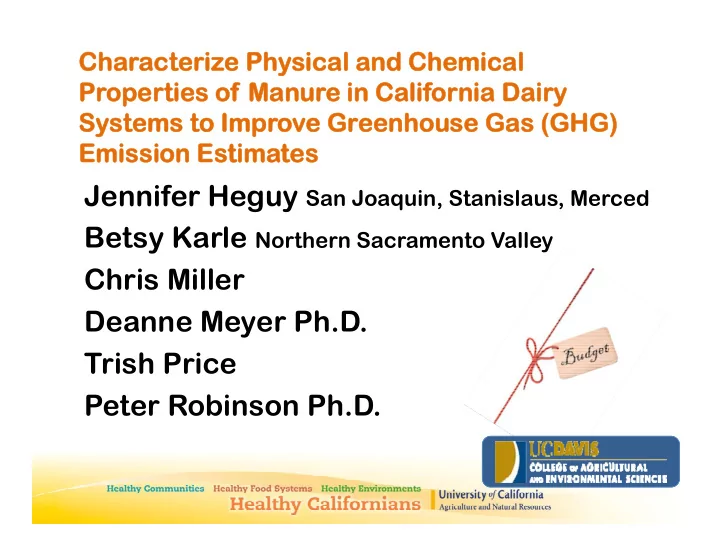

Char Characteriz acterize Phy e Physical and Chemical ical and Chemical Pr Proper operties of ties of Man Manure in Calif in California Dairy ornia Dairy Systems to Impr Sy stems to Improve Gr e Greenhouse Gas (GHG) eenhouse Gas (GHG) Emission Estima Emission Estimates tes Jennifer Heguy San Joaquin, Stanislaus, Merced Betsy Karle Northern Sacramento Valley Chris Miller Deanne Meyer Ph.D. Trish Price Peter Robinson Ph.D.
to our cooperating dairy operators, their employees, and their families. Request that images not be used without producer consent
Known at the beginning… • Every dairy was built and is operated independently. • The amount of excreted volatile solids (VS) stored in anaerobic conditions can range from 12.5% to nearly 100%. • Need to know amount or % VS excreted stored in anaerobic conditions to identify which management practices (if any) are useful.
Known at the beginning… • Nutrient management has driven much of treatment technology or alternative management practices researched in CA. Focus on N, P and K and not fate and form of C. • Any changes in manure management practices must be consistent with Regional Water Board requirements and Air District permits.
Known at the beginning… • Dairies and their manure management system do not run the same way every day. • Seasonal differences will have an effect on TS collected and methane production.
Known at the beginning… • There are large knowledge gaps. The Research sub-group (#3) is working to 40% of what? identify these. • Large uncertainties exist around baseline quantification which makes documentation of improvements (also with large uncertainties) sub-optimal. • Current working knowledge of California dairy manure management essential to design and apply research results.
Driving questions r Driving questions responsib sponsible f le for r this w this work 1. How much manure (tons as excreted or percent of animals) is handled aerobically (likely a solid) anaerobically (likely a liquid) other
Driving questions r Driving questions responsib sponsible f le for this w r this work 2. What chemical or physical conditions make all manure not equal to all manure? aerobically “anaerobically” pH, temp, redox, total solids loading rate, salt?, [NH 4 + ] other
UC T UC Team a am appr proac oach Task 1. Evaluate existing information on dairy practices and air emissions calculations in California Use of SJVAPCD data to identify animal populations by housing type, manure collection systems (solid, liquid, slurry). Use of Regional Water Quality Control Data when appropriate
Nothing is perfect • Animal numbers are maximum capacity and may not actually exist • Unable to differentiate between settling basins, pits, ponds • Unable to identify if all milking cows are in freestalls at freestall dairies • Unable to identify if heifers are in freestalls at dairies with freestalls
In general • Identify lactating cow housing type: freestall, non-freestall, or mix • Identify cow and herd distribution by facility size • Inform types of facilities to study in project
Desire for Task 2 dairies • 3 freestall and 2 non-freestall facilities • 1 to 2 dairies under 1,500 cows • 3 to 4 dairies between 1,500 and 3,000 cows
UC T UC Team eam appr pproac oach Task 2. Data collection Monthly feed and diet information analysis to estimate excretion Monthly animal management observations (where is manure deposited--must include bedding) Quarterly analysis of waste streams (how much manure is going where) lagoons (at least 3) for pH, redox, temperature
UC T UC Team eam appr pproac oach Site visits to select dairies (max n=5) with high probability of successful data collection for required information: Estimate TS, VS, TKN and “ammonium N” excreted Feed management and delivery Milk production pH, redox, temperature (liquid/slurry manure) Determine VS delivery to anaerobic system
UC T UC Team a am appr proac oach Leverage strengths in reading dairy facilities to facilitate a comprehensive survey and analysis of TS, VS and N flows from excretion through storage
What goes in, will come out
Need to know • How much VS in liquid system. – Straight forward approach – [VS] of liquid x volume of liquid = VS – Need representative samples – Need estimate of liquid volume • Liquid = water + manure + bedding + ??? • 12 months of sampling
Each dairy is operated independently • bedding – type – frequency – amount – composition (organic vs inert) – particle size – nutrient content
Each dairy is operated independently • water use – Animal consumption • leaky faucets – Animal cooling – Animal hygiene – Milk cooling – Milk equipment and parlor sanitation – other
Each dairy is operated independently • Reuse water from lagoon to flush • Flush water contains VS, volume can be estimated with uncertainty
Each dairy is operated independently • separation system – mechanical or gravity – retention time – frequency of clean out – method of clean out – removal of fines – how separated solids are handled • other treatment technologies • anaerobic lagoon management – see separation system plus introduction of fresh water
Management considerations • Hot weather abatement – Keep cows inside – Use animal cooling • Wet weather abatement – Keep cows inside – May collect more rain water • Impacts of bedding needs and potential bedding alternatives • Impacts of animal housing/management • Manure collection methods
Work in progress • Reviewed aerial photos of 177 randomly selected dairies (SJV) • Eighteen facilities met physical criteria. • Boots on the ground identified viable potential facilities.
Work in progress • Site visits were conducted to determine if sufficient infrastructure would be present. • Two freestall c. 2,150 and 2,250 cows facilities. We continue to look for another freestall facility. • Two non-freestall c. 1,000 and 1,800 cows
Making camp
Going forward • Continue field work. • Use data collected to understand how management preferences impact options for manure treatment technologies. • Fill data gaps.
Questions?
Recommend
More recommend